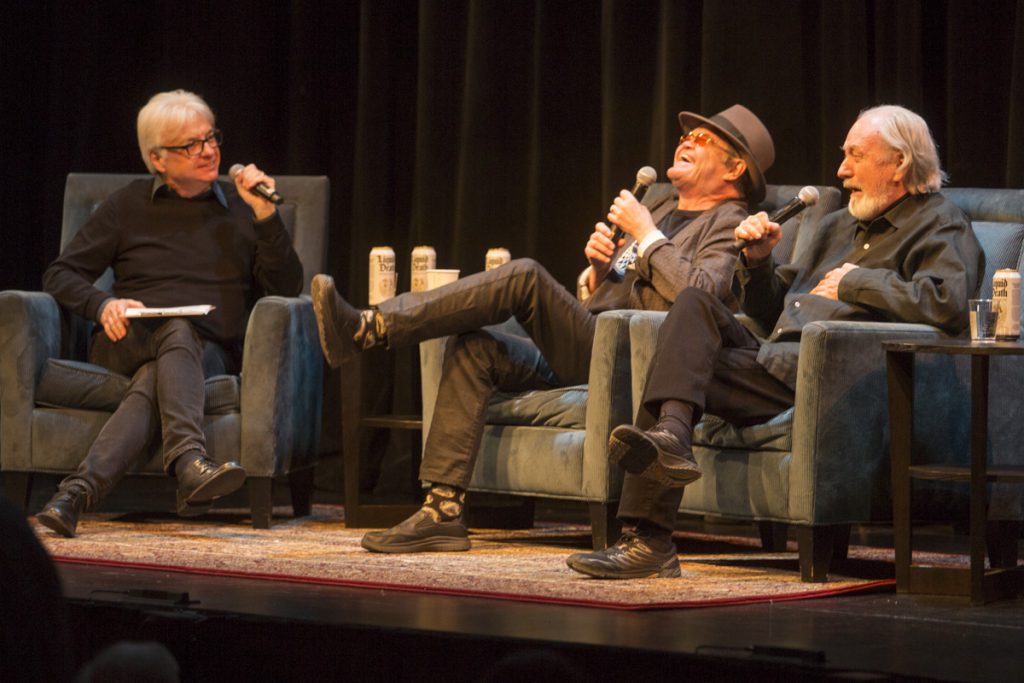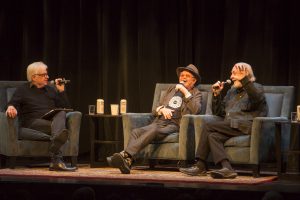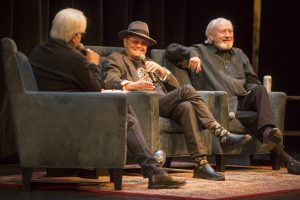SF Sketchfest: The Monkees’ Michael Nesmith and Micky Dolenz are ‘believers’ once again

Moderator Paul Myers (L) with The Monkees’ Michael Nesmith and Micky Dolenz at Marines’ Memorial Theatre on Jan. 12, 2020. Courtesy: Dan Dion.
SAN FRANCISCO — “I’m a Believer” and “(I’m Not Your) Steppin’ Stone” wafted through the Marines’ Memorial Theatre Sunday before SF Sketchfest’s Tribute to The Monkees: a conversation with surviving members Michael Nesmith and Micky Dolenz.
The conversation was moderated by self-described uber-fan Paul Myers, author of several pop culture biographies, who swore “The Monkees were better than The Beatles.” It precedes a reunion between the two that will include a new album and tour.
The evening was an informative conversation with Nesmith and Dolenz, who’s previously appeared at Sketchfest Celebrity Biography shows. Numerous times, the speakers even dove into how the drug culture of the ’60s affected the band.
“I don’t remember, but I was told I had a great time,” Dolenz of the years after the first season of their TV show aired. “I lied by my pool and drank with Alice Cooper.”
The two were endearing as they regaled the audience with stories of how The Monkees began, both as a band and a hit TV show. The show, which premiered in 1965, was created by young producers Bob Rafelson (“The Postman Always Rings Twice”) and Bert Schneider (“Easy Rider”). Their concept hinged on the idea of a show that would be improvised rather than scripted. Nesmith and Dolenz, as well as Davy Jones and Peter Tork (who passed away in 2019), learned improv from James Frawley, who made them watch the Marx Brothers and Laurel & Hardy. “The Monkees” became the first of many directing projects for Frawley.

Moderator Paul Myers (L) with The Monkees’ Michael Nesmith and Micky Dolenz at Marines’ Memorial Theatre on Jan. 12, 2020. Courtesy: Dan Dion.
The members were taught camaraderie as they grew to support each other. The plot of the show, about a band that wanted to be The Beatles, yet never succeeding, is what endeared countless fans, Nesmith and Dolenz said. At the same time, the show portrayed the band living in a beach house, with a nice car and surrounded by women.
“‘How did they do it?'” Nesmith joked. The magic of Hollywood.
The producers had a plan to get the band on the road at the outset, Dolenz said. All four Monkees could play instruments—and here Nesmith joked how unlike other great bands of the ’60s like The Beach Boys that often relied on the help of heavy-hitting session musicians The Wrecking Crew, The Monkees never did.
Then they got the “Monkeemobile,” built with a trailer attached that was dubbed “Big Red.” The trailer turned into a stage so they could play supermarket parking lots.
At the beginning of the TV show, Dolenz was studying to become an architect. His fallback was acting. At the time of The Monkees premiere, he’d also been attached to two or three other shows including “The Happeners,” along the lines of Peter, Paul and Mary and a surf rock band a-la The Beach Boys. A third show would have included him performing in a folk group like the The New Christy Minstrels.
Dolenz was fast-tracked through the audition process to The Monkees thanks to his work on “Circus Boy” in the late ’50s. He was a child actor playing the part of an orphan adopted into a circus family in the 1890s.
As he needed to be able to act and sing for “The Monkees,” he auditioned with “Johnny B. Goode.”
Nesmith, meanwhile, had been working at The Troubador in Los Angeles as a house musician. He saw an ad for the show and went in to audition.
Nesmith said he once created a rumor that Charles Manson auditioned for a part, as well as Sally Field and Lassie—there was never any truth to it, though surely the producers could have found a spot for Lassie, right?
Nesmith and Dolenz talked about how the two of them pulled a lot of pranks and gags together. As Dolenz explained one incident, while returning to the U.S. from a tour, immigration officers asked for the members’ “papers.”
Nesmith responded: “zig-zags or Bambus?”—a reference to joint rolling papers.

Moderator Paul Myers (L) with The Monkees’ Michael Nesmith and Micky Dolenz at Marines’ Memorial Theatre on Jan. 12, 2020. Courtesy: Dan Dion.
Of course, the elephant in the room was the absence of Tork and Jones. Infamously, there was a lot of infighting with the band behind the scenes.
“Do you have any brothers or sisters. Need I say more?” Dolenz said.
“I did not care for [Tork],” Nesmith said. And of Jones: “I tolerated him.”
Dolenz and Nesmith have an incredible bond, however. While Tork and Nesmith may have had their differences, Nesmith felt a great sense of loss when Tork passed away.
“We became brothers; we became a band,” Nesmith said.
Perhaps the most amusing story, as told by Dolenz, was the filming of Jack Nicholson’s first film, the cult-feature “Head,” a precursor to “Easy Rider.” After two seasons of “The Monkees,” the band agreed to the film “because of the drugs.”
Somewhere there is 16mm footage of what really happened.
Nicholson was a B-movie actor who just wanted to write, Dolenz said. The band went to Ojai to make the movie, and “we were all too stoned.”
Nesmith described the band’s success as lightning in a bottle.
“We were four guys who got a lucky break. When on stage we were undeniable,” he said.
Nesmith and Dolenz plan to release a new live album in April and head back out on the road later this year.
Follow writer Rachel Goodman at Twitter.com/xneverwherex and Instagram.com/xneverwherex.
